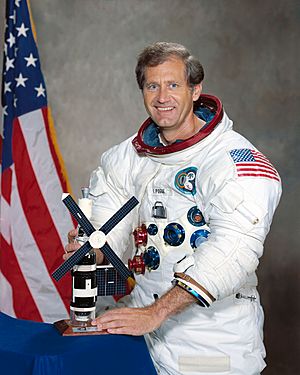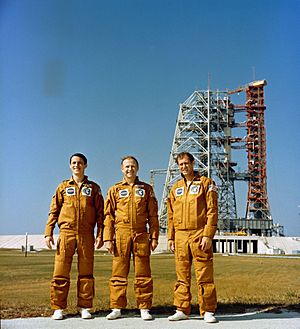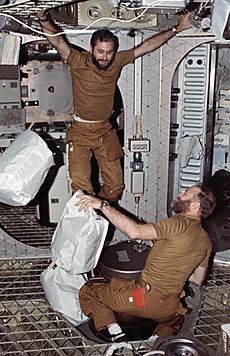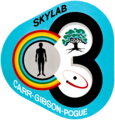William Pogue facts for kids
Quick facts for kids
William R. Pogue
|
|
|---|---|

Pogue in August 1975
|
|
| Born |
William Reid Pogue
January 23, 1930 |
| Died | March 3, 2014 (aged 84) Cocoa Beach, Florida, U.S.
|
| Nationality | American |
| Other names | Bill Pogue |
| Alma mater |
|
| Occupation |
|
| Awards | |
| Space career | |
| NASA Astronaut | |
| Rank | |
|
Time in space
|
84d 01h 15m |
| Selection | 1966 NASA Group 5 |
|
Total EVAs
|
2 |
|
Total EVA time
|
13 hours 34 minutes |
| Missions | Skylab 4 |
|
Mission insignia
|
 |
| Retirement | September 1, 1975 |
| Signature | |
 |
|
William Reid Pogue (January 23, 1930 – March 3, 2014) was an American astronaut and pilot. He served in the United States Air Force (USAF) as a fighter pilot and test pilot, reaching the rank of colonel. He was also a teacher, public speaker, and author.
Born and raised in Oklahoma, Pogue earned a degree in Education from Oklahoma Baptist University. He joined the USAF in 1951 and served for 24 years. He flew combat missions during the Korean War and was part of the famous USAF Thunderbirds aerobatic team. Later, he became a flight instructor. After getting a master's degree in mathematics from Oklahoma State University in 1960, he taught at the United States Air Force Academy. He also trained at the Empire Test Pilots' School and served as a test pilot, even spending two years working with the Royal Air Force (RAF).
In 1966, Pogue was chosen by NASA to become an astronaut. His NASA career included one space mission, Skylab 4. As the pilot of Skylab 4, he and his crew did many experiments in space. They set a record for the longest crewed spaceflight at the time, staying in orbit for 84 days. This record stood for over 20 years for NASA missions. During this mission, there was a disagreement with ground control about their schedule. News media called this event "The Skylab Mutiny." Pogue retired from the USAF and NASA a few months after his Skylab mission. After retiring, he taught and wrote about aviation and aeronautics. William Pogue passed away in 2014 at the age of 84.
Contents
Early Life and Education
William Pogue was born on January 23, 1930, in Okemah, Oklahoma. His parents were Alex Wallis Pogue and Margaret Frances Pogue. William had Choctaw ancestry. He had four siblings: two sisters and two brothers.
Pogue went to Lake Elementary School and Sand Springs High School in Sand Springs, Oklahoma. He finished high school in 1947. As a young person, he was part of the Boy Scouts of America. He earned the rank of Second Class. Pogue then attended Oklahoma Baptist University in Shawnee, Oklahoma. In 1951, he earned a Bachelor of Science degree in Education. Later, in 1960, he received a Master of Science degree in Mathematics from Oklahoma State University in Stillwater, Oklahoma.
Career Highlights
Flying Experience
William Pogue loved flying from a young age. He first flew an airplane while he was still in high school. In 1951, Pogue joined the United States Air Force (USAF). He completed his aviation cadet training program in 1952. He then became a second lieutenant in the USAF.
From 1953 to 1954, Pogue served with the Fifth Air Force during the Korean War. He flew 43 combat missions in fighter bombers. From 1955 to 1957, Pogue was a member of the USAF Thunderbirds. He was an aerobatics pilot for this famous team.
Pogue flew over 50 different types of American and British aircraft. He was also a certified civilian flight instructor. From 1960 to 1963, Pogue worked as an assistant professor in the mathematics department at the United States Air Force Academy in Colorado Springs, Colorado. He applied to be an astronaut in 1962 but was not chosen because he needed more pilot experience. In September 1965, Pogue finished a two-year assignment as a test pilot. This was part of an exchange program between the USAF and the Royal Air Force. He graduated from the Empire Test Pilots' School in Farnborough, England. At that time, he was an Air Force major. He then went to the Manned Spacecraft Center in Houston, Texas. Before that, he had been an instructor at the U.S. Air Force Aerospace Research Pilot School since October 1965.
NASA Astronaut Career

In April 1966, NASA selected Pogue as one of 19 new astronauts. They were part of Group 5 for the Apollo program. He helped support the crews for the Apollo 7, Apollo 11, 13, and Apollo 14 missions. He even took over as Capsule Communicator for Apollo 7 after another astronaut passed away. If the normal crew rotation had continued, Pogue might have been assigned as the command module pilot for the Apollo 19 mission, which was later canceled.

Pogue was the pilot for Skylab 4. This was the third and final crewed visit to the Skylab Orbital Workshop. The mission lasted from November 16, 1973, to February 8, 1974. At 84 days, 1 hour, and 15 minutes, it was the longest crewed spaceflight up to that time. This record stood until 1978 when a Soviet crew spent 140 days on the Salyut 6 space station. Pogue flew with Commander Gerald Carr and science pilot Edward Gibson. During their flight, they completed 56 experiments, 26 science demonstrations, and 13 student projects. They orbited Earth 1,214 times.
About six weeks into the mission, there were some disagreements between the crew and ground control. On December 28, 1973, the crew turned off their radio communication. They spent the time relaxing and looking at Earth from space. This event was later called the "Skylab mutiny" by the news. Pogue later said the team was "studying the Sun, the Earth below, and ourselves." After communication resumed, they reached an agreement to continue the flight, and tensions eased. In 1985, Pogue said the flight made him more understanding. He explained, "I try to put myself into the human situation, instead of trying to operate like a machine."
The crew also collected a lot of data about Earth's resources. They used Skylab's special camera and sensor system. They also spent 338 hours operating the Apollo Telescope Mount. This telescope made many observations of the sun's activities. Pogue and Carr saw a comet moving across the sky during a extravehicular activity (EVA), which is a spacewalk. Pogue spent 13 hours and 34 minutes outside the space station during two spacewalks.
On September 1, 1975, Pogue retired from the USAF as a colonel and from NASA. He then became vice president of the High Flight Foundation. During his career, Pogue logged 7,200 hours of flight time. This included 4,200 hours in jet aircraft and 2,000 hours in space.
After NASA
After leaving NASA, William Pogue worked as an aerospace consultant. He also made videos about space flight for the public. In 1985, Pogue wrote a book called How Do You Go to the Bathroom in Space?. This book answered 187 common questions he received about spaceflight. In 1992, he co-wrote a science-fiction novel, The Trikon Deception, with Ben Bova. He also advised aircraft companies like Boeing and Martin Marietta. He helped them develop technology for space stations. Pogue gave lectures for 40 years, speaking at over 500 schools and 100 clubs.
Personal Life and Passing
William Pogue was married three times. His first marriage was in 1952 to Helen Juanita Dittmar. They had three children together. He married Jean Ann Baird in 1979, and they were married until her death in 2009. Pogue's last marriage was to Tina, whom he married in 2012.
William Pogue passed away peacefully on March 3, 2014, at his home in Cocoa Beach, Florida. He was 84 years old. His ashes were sent into Earth orbit by Celestis, a memorial rocket service. This happened on a Falcon Heavy rocket on June 25, 2019. A plaque honoring his life was placed in Sand Springs, Oklahoma.
Special Honors and Awards
William Pogue and his Skylab crew members received many awards. Pogue won the Johnson Space Center Superior Achievement Award in 1970. The three Skylab crews, including Pogue, were awarded the 1973 Robert J. Collier Trophy. In 1974, President Richard Nixon gave the Skylab 4 crew the NASA Distinguished Service Medal. The Fédération Aéronautique Internationale also gave the crew the De La Vaulx Medal and Vladimir Komarov Diploma that year. Pogue was among nine Skylab astronauts who received the City of Chicago Gold Medal in 1974 after a parade with 150,000 people. The American Astronautical Society's 1975 Flight Achievement Award was given to the crew. Gerald P. Carr accepted the 1975 Dr. Robert H. Goddard Memorial Trophy from President Gerald Ford, which was awarded to the Skylab astronauts. They also won the AIAA Haley Astronautics Award in 1975.
The William R. Pogue Municipal Airport in Sand Springs, Oklahoma, was named in Pogue's honor in 1974. In February 1989, the Oklahoma Aviation and Space Museum gave him the Clarence E. Page Memorial Trophy. This award was for "making significant and ongoing contributions to the U.S. aviation industry." Pogue received an honorary doctorate of science from Oklahoma Baptist University in 1974. He also received the City of New York gold medal and the General Thomas D. White USAF Space Trophy in the same year.
Pogue has been inducted into three halls of fame. He was inducted into the Five Civilized Tribes Hall of Fame in 1975. In 1980, he was one of five Oklahoman astronauts inducted into the Oklahoma Aviation and Space Hall of Fame. In 1997, Pogue was one of 24 Apollo astronauts inducted into the U.S. Astronaut Hall of Fame. As a member of the USAF Thunderbirds, he earned the Air Medal, Air Force Commendation Medal, the National Defense Service Medal, and an Air Force Outstanding Unit Award.
Images for kids
See also
 In Spanish: William R. Pogue para niños
In Spanish: William R. Pogue para niños






